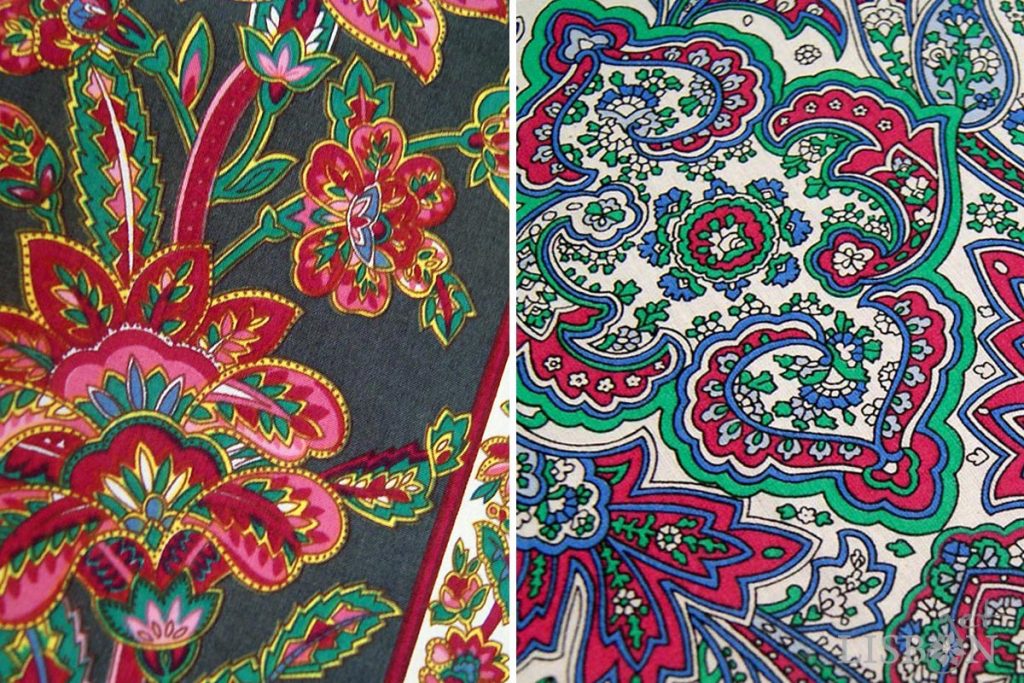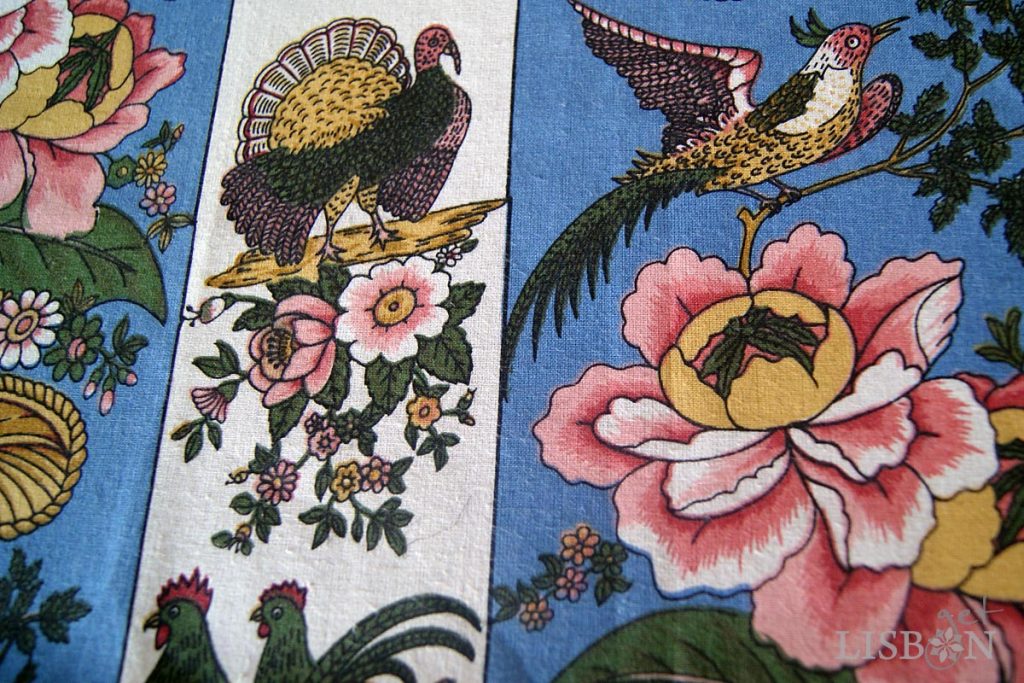Original article published on 13 March 2019
Updated on 14 October 2025
Chintz of Alcobaça is a very expressive and colourful woodblock printed Portuguese cotton fabric. The reason why it is called Alcobaça is still a mystery, seeing that this fabric was never produced in that city.
Did you know that one of the main production centres of chintz of Alcobaça was in Lisbon?
And that this product resulted from the globalisation from 500 years ago, initiated with the arrival of Vasco da Gama to India, along with the late industrialisation of Portugal in the end of 1700’s?
By bringing this subject we want to promote this multi-purpose traditional product, which used to be of great economic importance but that today lacks the appreciation it deserves, to everyone.
Unfortunately, today it is almost impossible to find traditional chintz of Alcobaça in Lisbon, but it would be important that the fabric shops would restart selling this product that reflects the culture, the patrimony and part of the Portuguese history. A cultural heritage that many of those who visit us appreciate and that we should value.
Due to the lack of documentation, catalogues and bibliography about the activity of woodblock printing in Portugal, it is difficult to gather much of information about decorative chintz. Nevertheless, we still have a lot to reveal!
After posting this article we had the opportunity of meeting the person who played the important role of revitalisating the patterns of chintz of Alcobaça in the 20th century, who kindly shared with us his story from which resulted two posts that you wouldn’t want to miss!
– The Unique Story of Chintz of Alcobaça in the 20th Century
– The Origin of the Names of Chintz of Alcobaça – Collection Elipas
Indian Chintz and its Arrival to Europe

In the 15th century, a highly developed production of colourful cotton fabrics with natural dye already existed in India. The designs were originally painted by hand, but the patterns were posteriorly woodblock printed.
It is known that this fabric was commercialised since ancient times in the East and brought to the Mediterranean region through the maritime trade routes.
The discovery of the maritime route to India by the Portuguese in 1498, brought to Europe colourful chintz from India, allowing the expansion of a more limited commerce until then.
Despite being better positioned, Portugal wasn’t particularly interested in this product, its taste was more inclined to luxury fabrics. However, Lisbon was the port of entry in Europe of all the goods coming from the East, including Indian chintz.

These fabrics were quite appreciated in upholstery, decoration and later on in clothing.
The Indian producers received orders with specific designs that altered the original patterns. Despite the adaptations to the European taste, the plant-inspired and floral elements continued being present and have endured until today.
The religious, economic and political conflicts between King Filipe II and the Netherlands led to the loss of importance of Lisbon as a commercial trade centre. Since then that chintz started being directly traded in the East by the Dutch, English and French, who quickly developed the art of printing fabrics. In the early 1700’s the cities connected to the commerce with the East already had woodblock printing workshops.
The use of chintz was so popular that the traditional producers of silk and wool fabrics demanded a ban on the importation of coloured cotton. This was the case of France and England, where even the its use was forbidden. This didn’t stop the upper classes from showing them off and the 70 years of this prohibition weren’t enough to eradicate the consumption and the taste for the “Indians”.


The Mystery of the Name Alcobaça

In Alcobaça there used to be a textile industry of spinning and weaving cotton, which was also mixed with linen and wool, that playwright Gil Vicente (1465-c. 1536) refers to in Farsa dos Almocreves.
However, the first factory registered in Alcobaça dates back to 1774 and is linked to the Pombaline industrial development policy. Here were produced handkerchiefs, batistes and other white fabrics.
In 1810 the 2nd French invasion destroyed the whole factory. The attempts to implement new production units in the following years were unsuccessful.
Later on, in 1875 was created the Companhia de Fiação e Tecidos de Alcobaça, a company of great importance for the economy and development of that region and that lasted until 1998, but that was also of spinning and weaving white cotton.
In truth, Alcobaça has never produced woodblock printed chintz, but only the fabric necessary to its production. The reason of the origin of its name chintz of Alcobaça is thus, still a mystery.
Get to know Lisbon’s historic neighbourhoods in a guided tour and discover unmissable places of this magnificent city.
Woodblock Printing in Portugal

Conditioning factors such as the history, economy, taste, and technique led to the woodblock printing industry in Portugal only emerging in the last quarter of the 18th century.
The traditional chintz of Alcobaça are one of the biggest enigmas of the Portuguese industrial archaeology. The lack of documents doesn’t allow us to clearly understand the particularities of each one of the printing workshops.
This fact derives from the low importance given to the closure of these factories, since the majority of them were small and simple craft workshops.
These, just like the large registered factory units, were located in the large cities of Lisbon and Porto, which allowed the draining of the products and raw materials, with particular importance the exportation to the colonies in Africa and Brazil.
The first officially recognised printing factory dates back to 1775, was located in Azeitão and served as a model for those that followed.
There were woodblock printing workshops in the centre of the city: Bairro Alto, Cais do Sodré, Olarias and Anjos. In the west zone of Lisbon: Vale de Alcântara and Calvário; in the east zone of Lisbon: Xabregas, Chelas, Marvila, Olivais, and in the north: Campo Pequeno, Campo Grande, Lumiar, Sete Rios, Campolide… As well as in bordering nearby municipalities and in a wider ring, but always with the Tagus river as a landscape, in the influential zone of Santarém.
Today it may difficult to imagine this, since the majority of the places mentioned are in the city centre, but at the time these were more rural areas. The factories, for the most part, were installed in palaces, convents, or in old abandoned manors… others were built from scratch, generally simple rectangular buildings with big windows, which allowed natural lighting and airy spaces for the fabrics to dry
The Patterns of Chintz of Alcobaça

The national patterns follow the trends of the European fabrics with eastern influence.
One of the most appreciated ones and that is still one of the most common ones is the pattern that alternates stripes that generally have different background colours.
The decorative motifs were countless and varied: small landscapes, human figures wearing exotic clothes, sculptures, cameos, animals such as dogs, squirrels, exotic birds, butterflies, chicken and turkeys, a vast variety of flowers in jars, baskets, birdcages, or cornucopias, fruits and abstract motifs like spirals or volutes.
Despite the strong oriental influence present in all European productions, each country developed their own style. For instance, the famous patterns toile de jouy and the colourful chintz from Provence are brand images of France
Chintz of Alcobaça, a Heritage to Requalify

The chintz of Alcobaça with magnificent and elaborate patterns, of great decorative value, have been devalued and despite some attempts to give it new uses, this is still a product considered popular, traditional or folcloric.
Although it is still produced, there aren’t many patterns anymore and the biggest challenge is to find shops that sell it.
We only know of two specialised shops in the entire country, in Porto and in Alcobaça, which in addition to having all patterns in various colours, sold by the metre, also have a variety of items produced with or inspired in chintz of Alcobaça.

And what about Lisbon? Unfortunately, Tavares & Tavares, in Rua dos Fanqueiros, has just closed down. It was one of the few traditional fabric shops where the chintz of Alcobaça could still be found. Nowadays, A Vida Portuguesa and Rosa Pomar offer a small selection of patterns.
Only the ignorance of history and the lack of an attentive observation of the designs can cause someone to assume that this is a product of low quality with no place in the current market.
The ceramics of Caldas da Rainha, namely the Bordallo Pinheiro ceramics, or even the Portuguese tiles went through the same process until they finally started being appreciated both by the locals and the foreigners. In the same way we can and must recover, and perhaps even reinvent the use of this patrimony, the chintz of Alcobaça, before it’s too late.
We appeal to the manufacturers that still produce chintz of Alcobaça to not abandon its production and, if possible, to reintroduce patterns that no longer exist, in order to diversify the supply.
Congratulations to the long-established Porto shop, Armazém dos Linhos, which sells and promotes the creation of new patterns and has, in recent years, worked to preserve this traditional craft despite the challenges brought about by real estate pressure that forced it to leave the premises it had occupied for over a century and relocate.
And to the sellers, to not give up on selling them, but especially to the designers, decorators and opinion leaders to look at our chintz of Alcobaça, to its high quality and economic and aesthetic potential… don’t let it die!
| Never miss another article | Subscribe here |
Curious Facts
Did you know that the terms chita (in Portuguese) and chintz are derived from the Sanskrit word “chint” that means spotted or variegated?
And that Sarasa is the Japanese designation for chintz?
This word is derived from the Portuguese word “saraça”, which means thin cotton fabric. It was the Portuguese that in the 16th century brought the Indian chintz to Japan. From it, they developed a fabric that is widely used in bedding, decorative pieces and kimonos, among others.
The project getLISBON has been very rewarding and we want to continue revealing the singularities of fascinating Lisbon.
Help us keep this project alive!
By using these links to make your reservations you’ll be supporting us. With no extra costs!
• Looking for a different experience? We can create a customised itinerary based on your interests. Contact us!
• Or if you prefer tours and other activities in various destinations, take a look at GetYourGuide.
• Save time and money with a flexible Lisbon Card!




